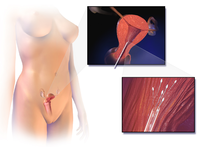
Photo from wikipedia
Our objective was to determine the effect of increasing the interval from induction of ovulation to timed artificial insemination (TAI) on fertility by decreasing the interval from TAI to ovulation… Click to show full abstract
Our objective was to determine the effect of increasing the interval from induction of ovulation to timed artificial insemination (TAI) on fertility by decreasing the interval from TAI to ovulation using sexed semen within a synchronized breeding program. Our hypothesis was that induction of ovulation earlier relative to TAI would increase pregnancies per artificial insemination (P/AI). Primiparous Holstein cows from 3 commercial dairy farms in the United States were submitted to a Double-Ovsynch protocol for first service as follows: Pre-Ovsynch (GnRH; 7 d, PGF2α; 3 d, GnRH), followed 7 d later by Breeding-Ovsynch [GnRH (G1); 7 d, PGF2α; 24 h, PGF2α], followed by the last GnRH treatment (G2), which varied between treatments, and TAI. To vary the interval between G2 and TAI, cows were randomized to 2 treatments to receive G2 either 16 (G2-16; n = 373) or 24 (G2-24; n = 357) h before TAI, which was fixed at 48 h after the second PGF2α treatment of the Breeding-Ovsynch portion of the protocol. All cows were inseminated with sexed semen, and each herd used sires of their choosing, which were randomly allocated between treatments. Pregnancy diagnosis was conducted by herd veterinarians using transrectal ultrasonography. In disagreement with our hypothesis, G2-24 cows had fewer P/AI than G2-16 cows at 34 ± 3 d (44 vs. 50%) and 80 ± 17 d (41 vs. 48%) after TAI. Pregnancy loss (5 vs. 6%) and fetal sex ratio (92:8 vs. 90:10, female:male) did not differ between treatments for G2-16 and G2-24 cows, respectively. Thus, we reject our hypothesis and conclude that induction of ovulation earlier relative to TAI with sexed semen for first service after a Double-Ovsynch protocol decreased P/AI in primiparous Holstein cows.
Journal Title: Journal of dairy science
Year Published: 2020
Link to full text (if available)
Share on Social Media: Sign Up to like & get
recommendations!